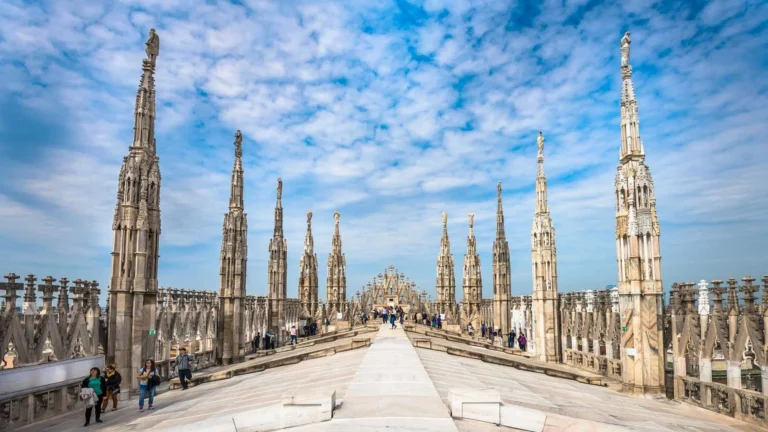
The Sagrada Familia is one of the most iconic and breathtaking architectural wonders in the world, located in the heart of Barcelona, Spain. This extraordinary basilica, designed by the visionary architect Antoni Gaudí, is a symbol of both architectural innovation and spiritual devotion. Construction began in 1882, and the basilica remains under construction to this day, making it one of the longest-running architectural projects in history. The Sagrada Familia’s intricate design, rich symbolism, and awe-inspiring facades have made it a UNESCO World Heritage Site and one of the most visited landmarks in Spain.
1. General Information
- Name: Basilica de la Sagrada Familia
- Location: Barcelona, Spain
- Architect: Antoni Gaudí
- Construction Start: 1882 (still under construction)
- Architectural Style: Modernisme (Catalan Modernism), Gothic Revival
- Function: Roman Catholic Basilica
- Status: UNESCO World Heritage Site
- Height (when completed): 172.5 meters (566 feet)
2. Historical Background
The construction of the Sagrada Familia began in 1882, with the original design by architect Francisco de Paula del Villar, who intended it to be a standard neo-Gothic church. However, in 1883, Antoni Gaudí took over the project and transformed it into a unique and ambitious architectural masterpiece. Gaudí dedicated the last 43 years of his life to the basilica, with the final 15 years focused exclusively on this project.
Gaudí’s vision was to create a “Bible in stone,” where every element of the basilica would symbolize stories from the Old and New Testaments. Tragically, Gaudí passed away in 1926, before seeing his vision fully realized. Since then, numerous architects and craftsmen have continued his work, adhering closely to the original plans while integrating modern techniques and materials. The basilica is projected to be completed by 2026, marking the 100th anniversary of Gaudí’s death.
3. Architectural Features
The Sagrada Familia is renowned for its blending of architectural styles, including Gothic and Modernisme. The basilica’s design is a profound reflection of Gaudí’s organic approach to architecture, inspired by the natural world.
A. Façades of the Basilica
The basilica features three grand façades, each representing a different phase of Christ’s life:
1. Nativity Façade (East Side):
- Completed during Gaudí’s lifetime, this façade celebrates the birth of Christ.
- It is richly decorated with natural motifs such as plants, animals, and figures representing joy and life.
2. Passion Façade (West Side):
- Represents the suffering and crucifixion of Christ.
- This façade is stark, angular, and dramatic, reflecting the pain and sacrifice of Jesus.
3. Glory Façade (South Side):
- The largest and most elaborate, symbolizing Christ’s resurrection and eternal glory.
- It is still under construction and will serve as the main entrance when the basilica is completed.
B. Towers and Their Symbolism
When completed, the Sagrada Familia will have 18 towers, each symbolizing significant figures in Christianity:
- 12 towers represent the Apostles.
- 4 towers symbolize the Evangelists.
- 1 tower honors the Virgin Mary.
- 1 central tower represents Jesus Christ, standing at 172.5 meters, making it the tallest religious structure in Europe.
C. Interior Design
- The interior of the basilica mimics a forest, with tall, branching columns resembling tree trunks.
- Natural light floods the space through stained-glass windows, creating a celestial and ethereal atmosphere.
- The ceiling is intricately designed to resemble a starry sky, drawing visitors’ gaze upwards in spiritual reflection.
4. Construction Techniques and Challenges
Gaudí was a pioneer in using innovative construction techniques. The basilica’s completion has faced multiple challenges:
- Funding: The Sagrada Familia is financed entirely through donations and visitor entrance fees.
- World Wars & Spanish Civil War: Construction was halted during these turbulent periods, delaying progress.
- Complex Design: Gaudí’s organic and geometric forms required advanced architectural techniques, which have only become feasible in recent decades through 3D modeling and modern materials.
5. Cultural and Religious Significance
The Sagrada Familia is not just an architectural wonder; it holds deep spiritual significance:
- Religious Symbolism: Every element of the basilica reflects biblical stories and Christian theology.
- Pilgrimage Site: It is an important place of worship and pilgrimage, attracting both the faithful and art enthusiasts.
- UNESCO Recognition: In 2005, parts of the Sagrada Familia were declared a UNESCO World Heritage Site in honor of Gaudí’s architectural genius.
6. Visitor Experience
Each year, millions of visitors from around the world come to admire the Sagrada Familia’s beauty. Visitors can:
- Explore the façades and towers, gaining panoramic views of Barcelona.
- Learn about Gaudí’s life and work in the Sagrada Familia Museum.
- Participate in religious services within the basilica.
Conclusion
The Sagrada Familia stands as a testament to human creativity, faith, and perseverance. Antoni Gaudí’s visionary design has transformed a simple church into a symbol of Barcelona and one of the most magnificent architectural achievements of modern times. As the basilica nears completion, it continues to captivate the world with its intricate beauty, profound symbolism, and the extraordinary legacy of Gaudí’s genius.
When finished, the Sagrada Familia will not only be an architectural marvel but also a spiritual beacon, reminding us of the power of faith, art, and dedication across generations.


No comments yet.